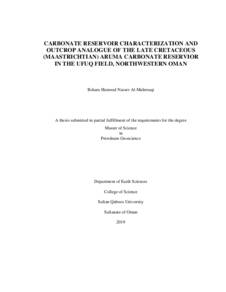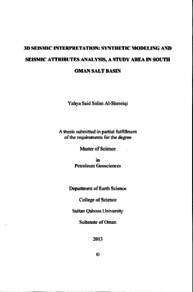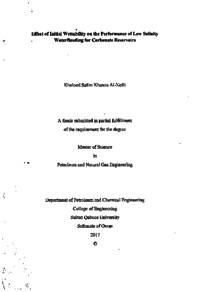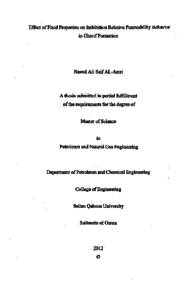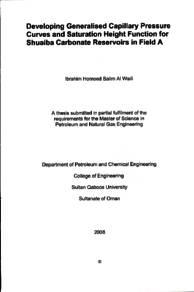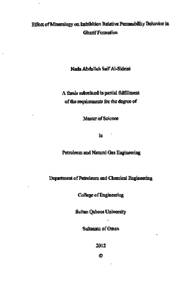Document
CARBONATE RESERVOIR CHARACTERIZATION AND OUTCROP ANALOGUE OF THE LATE CRETACEOUS (MAASTRICHTIAN) ARUMA CARBONATE RESERVIOR IN THE UFUQ FIELD, NORTHWESTERN OMAN
Publisher
Sultan Qaboos University
Gregorian
2019
Language
English
Subject
English abstract
The Late Cretaceous (Maastrichtian) Ufuq carbonate reservoir was discovered by accident in 2015 during drilling of Ufuq-XX exploration well in Ufuq Field, western Oman. Late Cretaceous (Maastrichtian) Ufuq reservoir is completely different (based on lithological and faunal assemblage) from the Late Cretaceous (Maastrichtian) carbonate which belongs to the Simsima Formation, across Oman. Therefore, according to stratigraphic nomenclature and rules, the Late Cretaceous (Maastrichtian) reservoir of the Ufuq Field cannot be assigned to the known Maastrichtian Simsima Formation. This research aims to characterize the Late Cretaceous (Maastrichtian) Ufuq carbonate reservoir by an outcrop potential analogue study. The probable outcrop analogue for the Ufuq subsurface reservoir, which is selected based on chronological similarities and lithology is, the Late Cretaceous (Maastrichtian) Upper Thaqab Member, which is exposed in Jabal Ruwaydah in Saham, north Oman.Jabal Ruwaydah is mapped in Saham map as Late Cretaceous deposits which belongs to the Upper Thaqab Member. However, Jabal Ruwaydah is mapped in Buraymi map with a scale of 1: 250,000 as belonging to both Late Cretaceous (Thaqab Formation) on the northwestern edge and Tertiary rock in the central and northeastern edge. Biostratigraphic result of this study is agreed with what has been published on the Buraymi map. The northeastern and central Jabal Ruwaydah contains faunal assemblage indicating Tertiary in age (late Paleocene to middle Eocene) which belongs to Ruwaydah Formation. However, the northwestern edge of Jabal Ruwaydah contains a diverse fauna of both large benthic foraminifera and planktonic foraminifera indicating Late Cretaceous age specifically latest Maastrichtian which represent the Upper Thaqab Member. Ecological distribution of Tertiary planktonic fossils is outer neritic zone environment while the ecological distribution planktonic foraminifera of Late Cretaceous age (Upper Thaqab Member) interpreted as outer neritic zone, relatively deeper (bathyal) than the Tertiary fossils.The Ruwaydah Formation is composed of four fining-upward sequences. The base of each sequence consists of a matrix-supported breccia passing up to intercalation of calcarenite and calcirudite and calcareous claystone. Limestone microfacies are dominated by hybrid composition of allocthonous (grain-supported texture) which in turn prevailed by different typified peloids and autochthons pelagic sediments. However, Upper Thaqab Member is prevailed by calcareous claystone interbedded by tabular bedded of polymictic breccia passing-upward to limestone. The depositional model of Ruwaydah Formation has been constructed based on deposit type, platform morphology and biota content, considered as slope carbonate apron model (grain-dominated) whereas, the Upper Thaqab Member is lope carbonate apron model (mud-dominated).Late Cretaceous (Maastrichtian) carbonate of Ufuq reservoir is characterized by the dominance of grain-supported texture (packstone and grainstone). The interpreted depositional system is a carbonate ramp (gentle slope) dominated by, inner ramp, shoal depositional system.The results of this study will shed light to further understand the Ufuq subsurface reservoir in the future such as diagenetic alteration and reservoir quality. Moreover, further detailed study for Jabal Ruwaydah is recommended for regional scale, basin analyses understanding.
Description
Thesis
Member of
Resource URL
Arabic abstract
تم اكتشاف خزان افق الكربونيتي في أواخر العصر الطباشيري (ماستريختين بحة الصدقة في عام 2015 تاء حقر یشر ققس في حفل قق، خیا۔ ورون هذا الخزان الدقيق في خواصه التكوينية عن نظيره خزان تكوين س نه المعروف، الذي بيني نفس العمر الجيولوجي وفقا لقوانين التسمية الضيقة، لا يمكن تحدی تو تین است س ينه إلي خزان قق المتن طريق دراسة احتمالية شاطره وتطايقه (زياء نوا وباقي الترسب مع الجزء القوي من تشرين نقاب الذي يقع في صحم، شمال الباطنة، ممشة في جبل ال البيضةكشفت التشنج الطيقة الحيوية (الأحفورية) أن شمال شرق ووسط جل رويضة يحتوي على تجميع حضوري يشير في العصر الثالث من القنوات اليت و تواضع في وعة من كل من فور اهنيفرا بنوعيها القاعة الكبيرة والعوالق التي تشير إلى العصر الطباشيري التأخر في وجه التحتية الفترة الماستريختية والذي يمثل الجزء العلوي من گوين نقاب. التوزيع البيئي للحفريات العراقية في العصر الأنت هو بيئة هادئة جدا تقع في الانحدر اليابسي بينما العوالق في العصر الطباشيري المتأخر يمثل نفس البيئة ولكن أعمق نصيبا من عوالق العصر الثالث.بتكون تكوين فريضة من أربعة تتابعات متتالية تتكون قاعدة كل تابع من البريشيا (المدعومة بحبيسات الطين) وتتدرج ألقيا إلي تداخلات طبقية من الكربونات ذو الحصيات ومزيج من الطين الكروبناتي والطين الحسيني، بناءا على التحليل المجهري لتوع الصخر فإن تكوين رويضة يحتوي على كوبونك هجيني مزيج من حبيبت والأحافير التي تتواجد فقط على البيت البحرية الضلة ومن الأحافير التي تتواجد في البيئات البحرية العميقة وقد اعتبرت بينة الشرسهب لتكرين رويضة هي کرونات المنحدر التي تهيمن عليها الحيات. يتاماتكوين نقاب تهيمن علبه حيات الكربونتبة الطبية الخضراء والتي تتخللها طبقات متوسطة وقليلة السائلة من الكربونات الصيني التي يغلب عليها التطبيقالنصفي) العنوان وبناء على التحليل المجهري، فإن تكوين نقاب يحتوي علي الأحافير اللاعبة الكثيرة التي تعيش في المية البحرية الضحلة والعروق الصغيرة التي تعيش في عمق البحر مع تواجد حياك غير كربونانية على سبيل المثال معدن الكوارتر. وقلت بينة الترسيب لتكوين ثقات على أنهاكربونات المتحف البحرية العميقة التي بين منها العين بينها تميز كرپونت خزان افق بهيمنة القوام المدعوم من الحبوب الصورة الحجرية و الحجر) ومنه فإن النظام الترسيي المقر هو متحدر كربونات يهيمن عليه، المنحدر الداخلي، في بيئة المياه الصحةسوف تسقط نتاج هذه الدراسة الضوء على مزيد من القهم لخزان فق في المستقبل وتتيح تر است هذه الدراسة توصي بالقيام بالعين من الدراسات التقنية والليله نجیت دوريحه مي يهدف إلى تحليل الحوض الرسوبيا
Category
Theses and Dissertations

